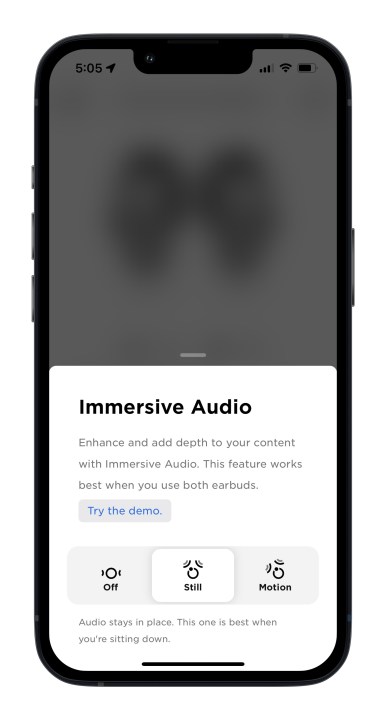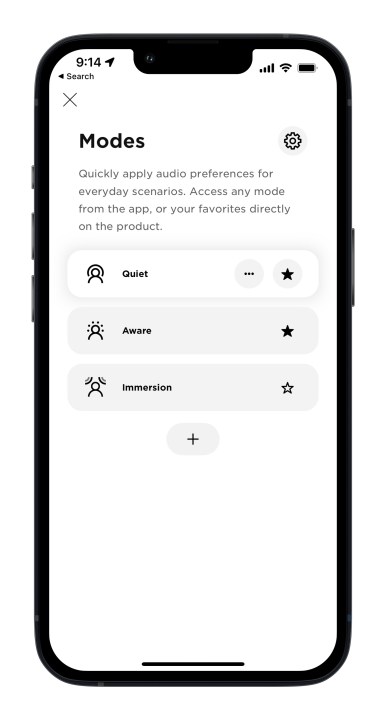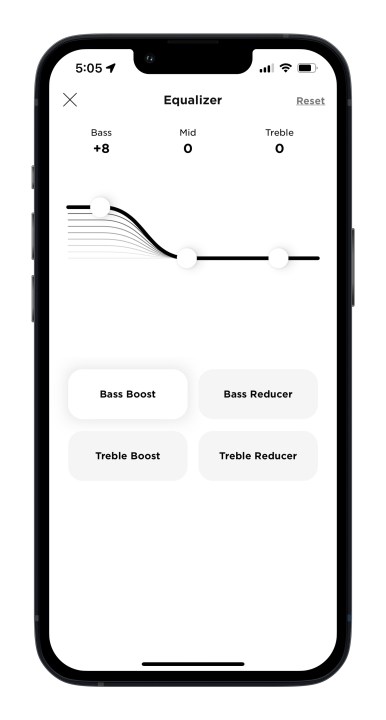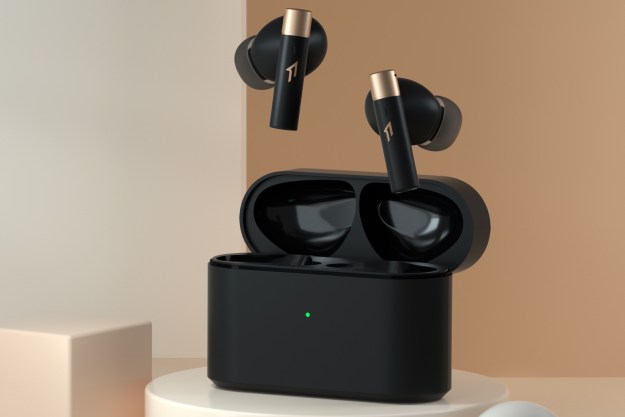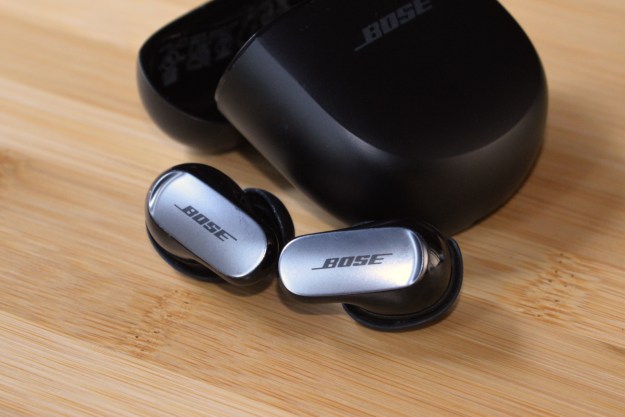
- Very comfortable
- Excellent sound quality
- Top-notch noise canceling
- Hi-res and lossless audio
- Excellent spatial audio
- No wireless charging
- No Bluetooth Multipoint
- Outdoor call quality could be better
I’m not gonna lie: It’s a little weird when a company like Bose trots out a new set of wireless earbuds like the QuietComfort Ultra Earbuds barely one year after it introduced its last set — 2022’s QuietComfort Earbuds II (QCE II). After all, wireless earbuds aren’t like smartphones. They don’t need to be refreshed every year. The market doesn’t expect it, and not that much changes in a year to warrant a refresh. And yet here we are.
So what was so important that we needed yet another set of QuietComfort earbuds? The price hasn’t changed — still $299. The Ultra Earbuds still can’t do Bluetooth Multipoint, and if you want wireless charging, you’ll need to pay an extra $49 for a bizarre silicone charging case cover.
It turns out that Bose simply couldn’t figure out how to deliver hi-res and lossless audio — which it had promised would be added to the QCE II — or spatial audio, without creating new hardware. Thus we now have the QuietComfort Ultra Earbuds.
Bose also took the opportunity to make a few other minor modifications but the bottom line is that the Ultra represent a small, incremental improvement of the QCE II. I used them for about 10 days; here’s what you should know whether you’re thinking of upgrading, or buying your first set of Bose wireless earbuds.
Bose QuietComfort Ultra Earbuds: design
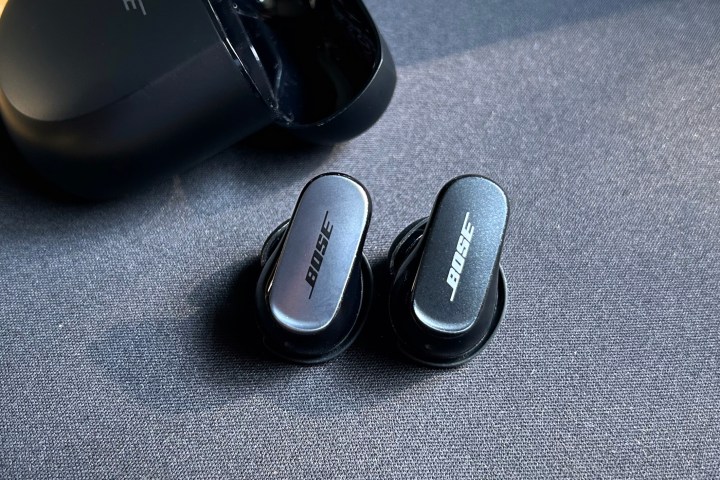
The Bose QuietComfort Ultra Earbuds and QCE II are almost identical from a design standpoint. That’s a very good thing. Though not quite as small and sleek as the Apple AirPods Pro, the Ultra look great, whether in black (seen here) or in white. Bose has given the Ultra a fresh coat of paint — literally — a new metallic layer adorns the main touch control surface, giving the buds a decidedly upscale look.
Bose has made a tiny change to the stability bands — the silicone loops that wrap around the body of the earbud to help them stay anchored in your ear. They now have a tab-and-notch design that ensures they sit correctly on the earbud when you swap them for a different size. You still get three sizes of bands (and three sizes of oval eartips) to work with.
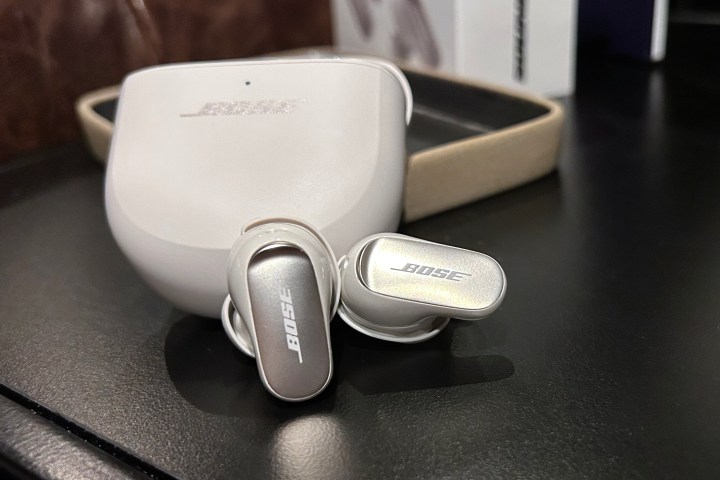
The charging case also is unchanged, save for a more prominent Bose logo. That’s not such a good thing. Overall, it’s still a good design and way more pocketable than the monster box that the original QuietComfort Earbuds came with. But I’d hoped that Bose would have taken the opportunity to add wireless charging — something that was conspicuously absent from the QCE II. Yet Bose tells me that doing so would have affected its ability to deliver the Ultra this quickly given the existing design architecture.
If wireless charging matters to you, Bose sells the $49 Bose Wireless Charging Case Cover. It works, but adds a fair bit of bulk to the earbuds.
Bose QuietComfort Ultra Earbuds: comfort and controls
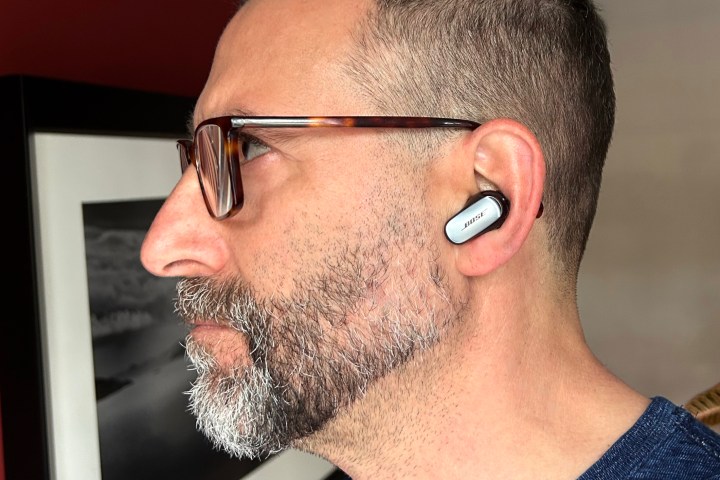
I find the QC Ultra Earbuds, like their predecessors, very comfortable to wear even for long periods. The portion that sits in your concha is relatively small and the combination of the smooth, rounded surfaces and the silicone eartips and stability bands makes for a very ergonomic shape. Unlike the AirPods Pro, which I find have a tendency to work themselves loose over time, I hardly ever felt the need to adjust the QC Ultras. For me, they were more than stable enough for my gym regimen, but I don’t do a ton of high-impact exercises. High mileage runners and CrossFit enthusiasts may still prefer an earhook-based design.
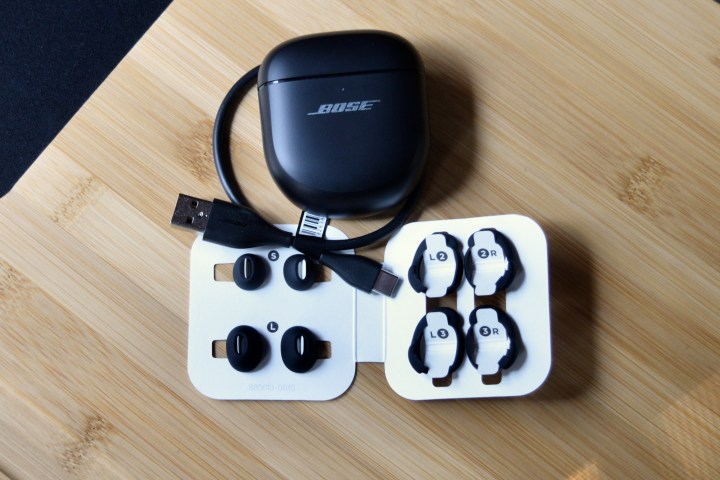
I still prefer physical buttons to touch controls. But as touch controls go, the QC Ultra are very good. Taps and swipes were almost always registered, and I’m a big fan of the swiping gesture used to control volume. To me, it’s the most convenient and accurate way to do volume changes on a set of earbuds.
Bose doesn’t let you customize the main gestures for playback, call management, or volume, but you do get a choice over how the long-press works on each earbud. By default, it’s set to ANC control, but you can also select spatial audio control and voice assistant control. Since I hardly ever use my phone’s voice assistant, I chose ANC and spatial audio and it worked really well.
Bose QuietComfort Ultra Earbuds: sound quality and spatial audio
I’ve always enjoyed the way Bose products sound. They have what I can only describe as an energetic sound signature, which tends to put a little extra sparkle on the upper-mids and highs. There’s no real difference between the QCE II and QC Ultra on this front — they both use Bose’s CustomTune technology to adjust themselves to your ears and they’re both a joy to use with a huge variety of genres.
What has changed is the QC Ultra’s support for additional audio formats. There are two big additions to QC Ultra: They now support Qualcomm’s Snapdragon Sound platform — an overarching set of technologies that includes the aptX family of hi-res Bluetooth codecs, plus some improved Bluetooth bandwidth for voice applications — plus they incorporate Bose’s new immersive audio tech, which can be thought of as very similar to Apple and Jabra’s spatial audio modes on the AirPods family and the Elite 8 Active and Elite 10 wireless earbuds.
First, let’s discuss those Snapdragon Sound aptX codecs. The QCE II were limited to SBC and AAC codecs, which are lossy and thus just fine for listening to Spotify, but not a great choice when trying to hear the extra detail in a CD quality or hi-res lossless track from Apple Music or Amazon Music. With aptX Adaptive (and a reliable Bluetooth connection) you can get far greater fidelity. It’s not theoretical. When listening to the QC Ultra on a Xiaomi 12 Pro and a Motorola ThinkPhone, the soundstage took on noticeably better precision, depth, and detail versus listening on an iPhone 14 (AAC only). It’s the same bump in quality that I’ve heard when using other equally capable wireless earbuds or headphones.
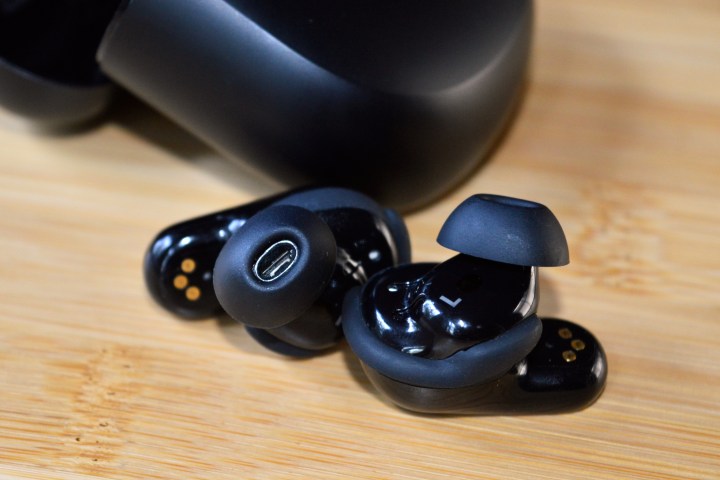
But with the QC Ultra, that bump came with a bit of a surprise. Normally, on the iPhone, when listening to bass-heavy tracks, like Hans Zimmer’s Warming Up My Instruments or Bob Dylan’s Man in the Long Black Coat, the QC Ultra (and the QCE II) respond by delivering incredibly deep, almost sub-bass tones. If you’re a bass-head, it’s kind of awesome, but it’s not a very balanced approach. Switch over to aptX Adaptive and it’s almost as if the earbuds switch to a different EQ setting. The bass becomes tempered; it’s more musical and less boomy.
I’d love to tell you that aptX Lossless, which is only available when you have a compatible Snapdragon (i.e. Android) phone, is even better, but I’ve struggled to identify the difference between aptX Adaptive and aptX Lossless in the past, and it was equally hard with QC Ultra. Still, perhaps those with even more finely tuned ears will be able to appreciate it.
As delighted as I am that the QC Ultra now support hi-res audio via Bluetooth, I was far more struck by Bose’s efforts in spatial audio.
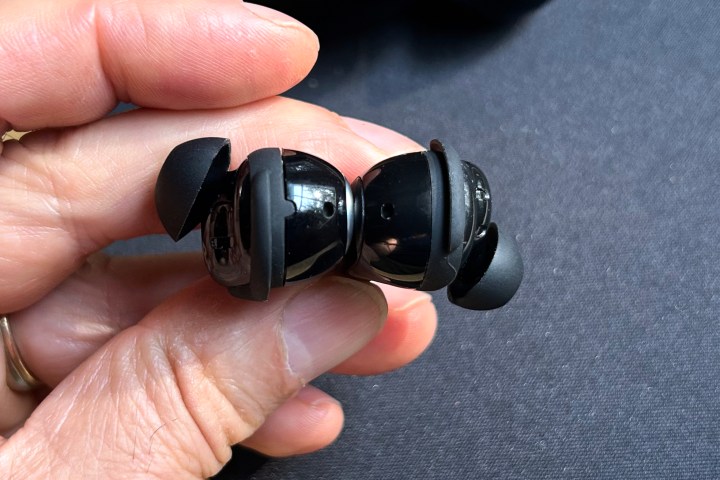
From a conceptual point of view, Bose isn’t doing anything new here. Just like Jabra’s Elite 10, Apple’s AirPods Pro, and the LG Tone Free T90Q, Bose uses software to simulate what it sounds like to listen to your music as though it were coming from large speakers in your room as opposed to tiny speakers wedged in your ears. It then uses gyroscope sensors to offer you an added level of realism by fixing those speakers in space relative to your head position. Turning your head one way or the other sounds like you’re turning away from the source of the sound.
The difference is that Bose’s version of spatial audio sounds better to me. I like the way it creates a virtual set of point sources that appear to be in front and slightly above where I’m sitting. It manages to do this without the corresponding loss of detail that sometimes accompanies Dolby Atmos Music tracks when you hear them via headphones. And when you engage the head tracking mode, it’s impressively smooth. Apple’s head tracking does an amazing job of simulating a 5.1-channel home theater system when you use the AirPods Max with an Apple TV 4K. and Bose’s immersive audio does the same thing but with a two-channel stereo arrangement. Unlike Apple’s tech, which requires either Dolby Atmos or Dolby Digital 5.1, Bose’s system works with any content — even phone calls.
For a while, I was dubious as to whether people would genuinely prefer spatial audio to classic stereo. After having spent time with the QC Ultra, I’m closer than ever to believing a day may come when we look back at stereo the way we used to look back at AM radio.
Bose QuietComfort Ultra Earbuds: ANC and transparency
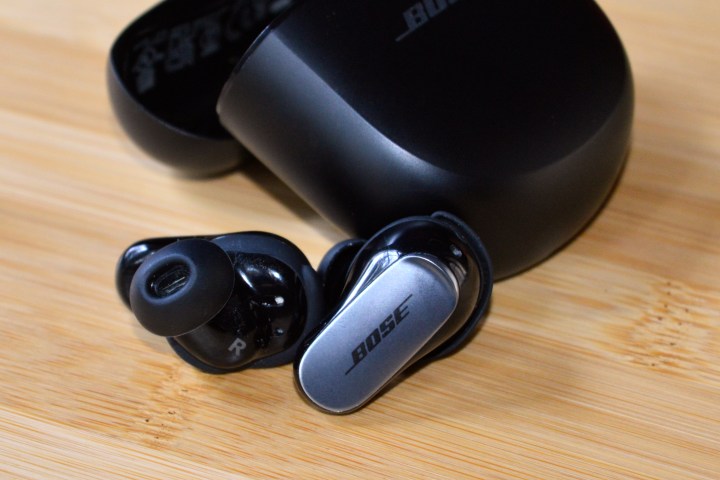
The QC Ultra, when it comes to active noise canceling (ANC), are just about the best you can get. While it’s true that both Apple’s AirPods Pro and Sony’s WF-1000XM5 are also superb in this regard, we’re talking about fractional differences. I wouldn’t pick one as clearly better.
The same isn’t quite as true for transparency mode. As good as the QC Ultra are (and they are very good), the AirPods Pro are still the reference, with an uncanny ability to just disappear when you engage transparency mode.
However, Apple is proving that it knows how to tweak the magic of ANC and transparency in new and useful ways. The conversational awareness and adaptive noise control modes introduced to the AirPods Pro with iOS 17 are proof that noise cancellation can become a highly dynamic and responsive feature when a set of earbuds can monitor things like your voice or the outside world. This puts Bose in catch-up mode once again.
Bose QuietComfort Ultra Earbuds: call quality
Bose says it has improved call quality on the QC Ultra by making more intelligent use of the microphones, especially in windy conditions.
I’m not sure I was able to detect much of a difference. But in fairness, I had only mildly breezy conditions while I was testing them.
Overall, the QC Ultra are good for calls — your callers will have no problem understanding you — but Bose’s environmental noise cancellation still needs work. Loud sounds still make their way through and as that happens, your voice becomes echo-y and distant, making it sound like you’re speaking from across the room. Indoors, things are far better, but that’s usually true of wireless earbuds.
Bose QuietComfort Ultra Earbuds: battery life
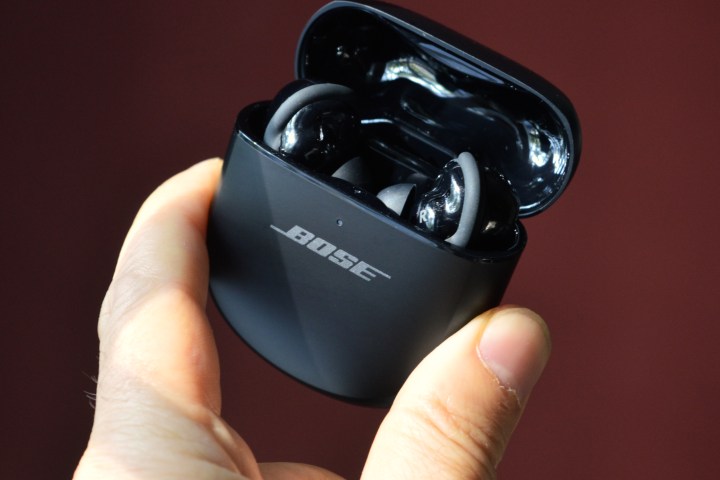
Bose has never wowed us with its battery life, and you won’t find much in the way of big numbers on the QC Ultra. They’re the same as the QCE II for single-charge play time (about six hours at 50% volume), and total time (24 hours when you include the case). However, this drops considerably when using immersive audio: down to four hours per charge or 16 hours total. That’s a big hit to battery life. The AirPods Pro also pay a price for spatial audio, but it’s a small one by comparison — just a 30-minute drop in stamina.
Since Bose hasn’t changed the price — the QC Ultra maintain the QCE II’s $299 cost — and you’re getting some decent upgrades in terms of audio capabilities, I’d have to say there’s never been a better time to buy a set of Bose wireless earbuds if you were thinking of taking the plunge. On the other hand, since there’s still no Bluetooth Multipoint, and you can now add wireless charging to either generation for $49, it’s hard to argue these are a must-have upgrade. Still, if you’re keen to jump into the world of spatial audio, I can think of no better wireless earbuds to take you there.
Editors' Recommendations
- Nothing’s new earbuds upstage Apple, Google, and Amazon by embedding ChatGPT
- Cambridge Audio’s first AirPods Pro competitor has lossless audio, massive battery life
- Best Bose QuietComfort Ultra deals: Save $50 on the headphones
- Audio-Technica’s latest hi-res earbuds debut at CES 2024 for $199
- Sennheiser Momentum True Wireless 4 debut with lossless audio, but skip the spatial trend


